|
|
|
|
Gujarat Tours |
|
|
|
|
|
|
|
|
|
|
|
|
|
|
|
|
|
|
|
|
|
Gujarat Hotels |
|
|
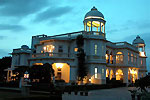 |
|
|
|
|
|
|
|
|
|
|
|
|
|
|
|
|
|
|
|
|
|
|
|
|
|
|
|
|
|
|
Gujarat
Pilgrimage |
|
There are various places
of pilgrimage in Gujarat like Somnath, Dwaraka, Junagadh,
Palitana, Modhera. The Mount Girnar in Junagadh and
Shatrunjaya Hill in Palitana are the two famous pilgrimage
places of the Jain community. While, the Somnath temple in
Somnath, Dwarakadhish temple in Dwaraka, Sun Temple in
Modhera and Akshardham temple in Gandhinagar are the other
famous pilgrimage of the Hindus. Ahmedabad is also visited
by many tourists for its mosques and temples. |
|
Ahmedabad, Gujarat |
|
|
Jama Masjid
The Jama Masjid was built by Ahmed Shah in 1423. The
building materials were provided to this mosque by the
demolished Hindu and Jain temples. The 260 columns
support the 15 domes at different elevations. There
were once two shaking minarets, but they lost half
their height in the great earthquake of 1819 and 1957.
The 2001 earthquake then took its toll, leaving cracks
in the masonry and destroying several jalis.
Ahmed Shah's
Mosque |
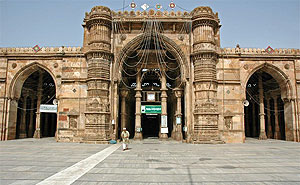 |
|
|
The Ahmed Shah's Mosque is
situated southwest of the Bhadra Fort and built in 1414. The
Ahmed Shah's Mosque was one of the city's earliest mosques.
It has an elaborately carved ceiling with a circular
symmetry, beautiful pillars and jalis reminding of the Hindu
and Jain temples.
Sidi Saiyad's Mosque
Sidi Saiyad's Mosque, close to the river, was once part of
the old citadel wall. Sidi Saiyad Mosque was constructed in
1573 by Sidi Saiyad, a sometime slave of Ahmed Shah and a
general of Abysinian origin. This mosque is one of the
Ahmedabad's most stunning buildings. This mosque is best
known for its intricate perforated stone work and has
beautiful carved stone windows or jalis which depict the
intricate intervening of the branches of the kalpa tree.
Sidi Bashir Mosque
Sidi Bashir Mosque is situated south of Ahmedabad station,
outside the Sarangpur gate. This mosque is famous for its
21.3 meters high shaking minarets which were built to shake
to protect against the earthquake, and this certainly worked
in 2001.
Rani
Sipri's Mosque
The Rani Sipri's Mosque is situated to the southeast of the
centre of the Ahmedabad city. This small mosque is also
known as the Masjid-e-Nagira or Jewel of the Mosque due to
its graceful construction, with slender minarets. It is said
to have been commissioned in 1514 by the wife of Sultan
Mahmud Begara after he executed their son for some minor
mistake. She is also buried here. |
|
Rani Rupmati's
Mosque
Rani Rupmati's Mosque is situated to the north of the
centre of the Ahmedabad city. This mosque was built
between 1430 and 1440 and was named after the Hindu wife
of the Sultan. The minarets were damaged in the great
earthquake of 1819. The dome is elevated to allow light
in around its base. This mosque combines elements of
Hindu and Islamic design.
Hathee Singh Jain Temple
Hathee Singh Jain Temple is situated outside Delhi Gate,
north of the old city. This temple is typically
|
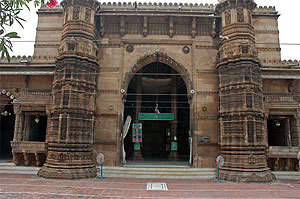 |
|
|
fine and made of
delicately carved white marble. This jain temple was built
in 1848 and dedicated to Dharamanat, the 15th Jain
tirthankara.
Swaminarayan Temple
Swaminarayan Temple is situated in the old Ahmedabad city.
This glorious, multicoloured, woodcarved temple looks like a
grand haveli dating from 1850, enclosed in a large
courtyard. |
|
|
Diu,
Gujarat |
|
|
St, Paul's Church
St. Paul's Church was founded by Jesuits in 1600 and then
rebuilt in 1807. Inside it is a great barn, filled with
heavy dark wood, with a small cloister, next door.
St. Thomas Church
St. Thomas Church is a lovely simple building housing the
Diu Museum. There is a spooky, evocative collection of worn
Catholic statues. Once a year, on 1 November, this is used
for a packed out mass. There are also some reamains of the
Jain |
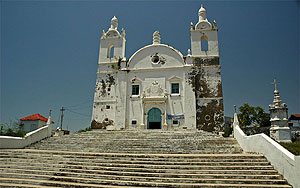 |
|
temple. There is a guest
house upstairs and you can also climb the roof for amazing
views. |
|
Dwaraka, Gujarat |
|
|
Dwarkadhish Temple / Jagat Mandir
Dwaraka is known all over the world for the
Dwarkadhish temple, the 'Lord of Dwaraka'. This temple
is also known as the Jagat Mandir or the temple of the
world. This temple was constructed over 1400 years ago
and houses the image of Lord Krishna. This temple is
one of the most famous pilgrimage place for the Hindus
and attracts pilgrims from all over the world. This
temple is magnificently built on the traditional lines
and has five floors supported by 60 columns. The
temple is profusely carved from the base to the
pinnacle. The temple is |
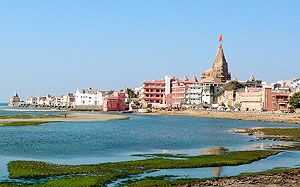 |
|
|
built of sandstone. The
interior is simple while the exterior is covered with
elaborate carvings. Some of the major festivals of
Janmashtami and Navratri are celebrated with great
enthusiasm and rejoicing in the Dwarka. After visiting the
main temple, some of the devotees visit the Shankhoddhar
Beyt or Beyt Dwaraka. |
|
|
Gandhinagar, Gujarat |
|
|
Akshardham
Temple
The Akshardam temple is one of the famous temple in
Gandhinagar, Gujarat. This temple belongs to the wealthy
Hindu Swaminarayan Group. This temple was built by nearly
1000 artisans. It is an elaborately carved building
constructed out of 6000 tonnes of pink sandstone and
surrounded by the manicured lawns and perfect trees. In
September 2002, this temple was attacked by the terrorists.
|
|
|
Jamnagar, Gujarat |
|
|
Bala
Hanuman Temple
At the Bala Hanuman Temple on the southeastern side of
the Ranmal lake, there has been continuous chanting of
the prayer Shri Ram, Jai Ram, Jai Jai Ram since 1
August, 1964. This devotion has earned the temple a
place in the Guiness Book of World Records. Early
evening is a good time to visit as the temple and
whole lakeside gets busy.
Jain Temples
In the thick of Chandi Bazaar are four beautiful Jain
temples. The larger two, Shantinath Mandir and Adinath
Mandir, dedicated to the 16th and first Tirthankaras,
in front of the post office near the . |
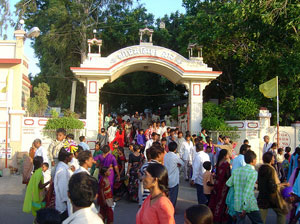 |
|
|
Darbar Gadh, explode with
fine murals, mirrored domes and elaborate chandeliers. The
Shantinath Mandir is particularly beautiful, with coloured
columns and a gilt-edged dome of concentric circles |
|
|
Junagadh, Gujarat |
|
|
Mount Girnar
Mount Girnar is most sacred to the Jain community.
This hill is situated in Junagadh and rises to a
height of more than 600 m, a climb marked by 10,000
stone-steps. On this hill various Hindu and a group of
16 Jain temples are located. This sacred hill is
visited by millions of Hindus and Jains. The Amba Mata
temple is situated on the top of the hill. The newly
weds came here and worship the Amba Mata in order to
ensure a happy marriage. One of the largest and the
oldest Jain temple, dedicated to Neminath, the 22nd
Jain Tirthankar and Mallinath, the 19th Jain
Tirthankar are situated just below the Amba Mata
temple. Besides this the Bhavnath temple is also
located on this hill. The Bhavnath temple is dedicated
to the Lord Shiva. The Mahashivaratri fair held here
is attended by Nagasadhus and pilgrims from all over
India. When a traveler to Gujarat, Joss Graham,
climbed up the hill forthe festival of Shivaratri, he
slept there overnight. He woke up on hearing the
praying murmurs of the great mass of devotees, about
100,000 of them in their communities and tribal
groups. There is also the temple of Samprati Raja, a
fine example of the later period and the Melak Vasahi
temple. |
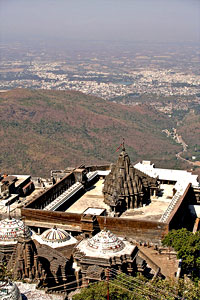 |
|
|
|
Damodar Kund
Damodar Kund is a holy water reservoir that marks the ascent
to the Girnar temples. It is surrounded by a well-built ghat.
It is believed that here Lord Krishna placed a flower
garland around the neck of the great poet and saint Narsinh
Mehta. |
|
|
Modhera, Gujarat |
|
|
Sun Temple
The 11th century Sun temple is situated on a knoll in
Modhera, about 106 kms. north west of Ahmedabad. The
Sun Temple was built by King Bhimdev I in 1026-27 AD,
two centuries before the Sun Temple at Konark. This
temple is one of the finest Hindu temples in Gujarat,
built by the great Solanki dynasty. This temple and
the Konark Sun temple in Orissa are very similar. This
similarity is that this temple was also designed in
such a way so as to let the sun shine on the image of
Surya, at the time of dawn. The main hall and shrine
are reached through a complex, pillared pavilion.
Beautiful columns and magnificent carvings decorate
the hall. The exterior of |
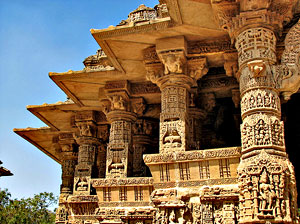 |
|
|
the temple is intricately
and delicately carved, showing demons and evolving
gods. Despite its partial destruction by Mahmud of Ghazni
and by subsequent earthquakes, it remains an outstanding
monument, set against the backdrop of the barren landscape.
Fifty two intricately carved pillars depict scenes from the
Ramayana and Mahabharata. Unlike the exterior, the interior
hall is plain with 12 niches representing the Surya's
different monthly manifestations. |
|
|
Palitana, Gujarat |
|
|
Shatrunjaya Hill
The Shatrunjaya Hill is located at a height of 591
metres. The Shatrunjaya Temple is the most sacred
temple of the Jains and one of the largest of its kind
in India. One has to climb up the hill for about 4 kms
(600 meters) on a stepped path to Shatrunjaya (place
of victory over worldliness). You can reach this place
either in Doli or lift chairs or by walking. The rich
persons visit this place on richly caparisoned
elephants. There are about 863 white marble Jain
temples, built over 900 years on the hilltop, each
with its own enclosure. There is a stunning view from
the top of the hill. On a clear day, you can also see
the Gulf of Cambay. All the temples are enriched with
|
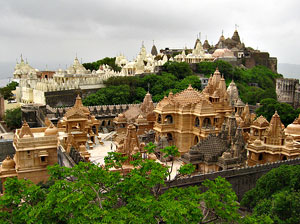 |
|
|
gold, silver and jewels
donated by rich merchants. Shri Adishwar temple is the first
and finest temple on the Shatrunjaya Hill. This temple is
dedicated to Shri Adishwar, one of the most important Jain
Tirthankars. This temple is one of the most magnificent and
sacred temple of the Jains community. The Chaumukh or
four-faced temple is the biggest temple located on the hill.
This temple was built by a wealthy merchant in 1618 to save
his soul. This temple has an image of Adinath which face out
in the four cardinal directions. On the top of the hill a
Muslim shrine of Angar Pir is also located where the
childless women offer tiny cradles in the hope of
conceiving. Besides these, there are various other temples
like Kumar Pal, Vimal Shah and Sampriti Raj, named after the
wealthy Jain merchants. |
|
|
Porbandar, Gujarat |
|
|
Bileshwar
Bileshwar is located about 15 kms. east of Porbandar in
Gujarat. The Siva Temple dates from the early 7th century
and is one of the finest examples of early temple
architecture in Gujarat. The enclosure is later but the
temple itself has a multi storey tower which is more like a
pyramid than a spire. The exterior is decorated with arch
like motifs but much of the detail has been obscured by a
plastic coating.
Gop
Gop is situated about 50 kms. north east of Porbandar and
midway on the Porbandar-Jamnagar road. The 6th century
temple dates from the Maitraka period (6th - 8th centuries)
and is a rare example of an early Hindu temple. The
sanctuary is on a raised platform and has a pyramidal roof
with an amalaka topping off. The whole is in a dilapidated
state. |
|
|
Somnath, Gujarat |
|
|
Somnath
Temple
The legendary shore temple of Somnath is located near
Veraval and is about 80 kms from Junagadh. The Somnath
temple is one of the twelve most sacred shrines
dedicated to Lord Shiva. The temple contains the
Jyotirlinga of Lord Shiva. This temple has a very long
history. According to the legends, the Somnath temple
is very old and was originally built in gold by the
Somraj, the Moon God. Later, it was rebuilt by Ravana,
in silver; then by Krishna in wood and by Bhimdev in
stone. Mahmud of Ghazni, upon hearing the description
of the richness of the Somnath temple by Al Biruni, an
Arab traveller, |
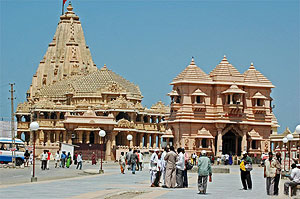 |
|
|
visited this temple in
1024 AD. At that time, this temple had about 300 musicians,
500 dancing girls and 300 barbers to shave off the heads of
pilgrims. After a 2 days battle, Mahmud destroyed the temple
and carried away jewels and gold to his homeland. Hence, a
tradition got started, the Muslims destroy the temples and
the Hindus rebuilt them. The Somnath Temple was raided again
in 1927, 1934 and 1706. In 1706, this temple was raided by
the Mughal emperor Aurangzeb. In all, the Somnath temple was
rebuilt and destroyed eight times. This temple was finally
rebuilt in 1950 with the support of Sardar Vallabhabhai
Patel. The current temple was built as per the traditional
designs on the original site by the sea and is a serene,
symmetrical and sinuous structure. Today, this majestic
temple is a replica of the earlier temple.
Bhalka Tirth
Bhalka Tirth is situated halfway between the Veraval and
Somnath. At this place, the Lord Krishna was mistaken for a
deer and wounded by an arrow. The legendary spot is at the
confluence of the three rivers. This place is entered
through the small Sangam (confluence gate), known as the
Nana. North of this sacred spot is the Suraj Mandir or Sun
Temple. This ancient temple was destroyed by the Mahmud of
Ghazni. The temple, with a freize of lions with elephant
trunks, probably dates from the same time as the Somnath
temple.
|
|